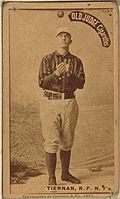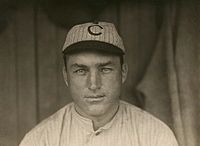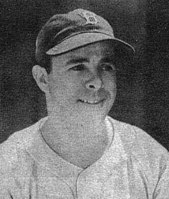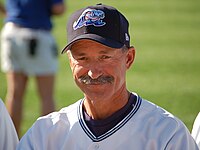
Robert Moses "Lefty" Grove was an American professional baseball pitcher. After having success in the minor leagues during the early 1920s, Grove became a star in Major League Baseball with the American League's Philadelphia Athletics and Boston Red Sox. One of the greatest pitchers in history, Grove led the American League in wins in four separate seasons, in strikeouts seven years in a row, and had the league's lowest earned run average a record nine times. Over the course of the three years from 1929 to 1931, he twice won the pitcher's Triple Crown, leading the league in wins, strikeouts, and ERA, while amassing a 79–15 record and leading the Athletics to three straight AL championships. Overall, Grove won 300 games in his 17-year MLB career. He was elected to the National Baseball Hall of Fame in 1947.
The following are the baseball events of the year 1884 throughout the world.

Harry Harlan Mowrey was an American professional baseball third baseman who played in the Major Leagues from 1905 to 1917. He also later played for the Cincinnati Reds, St. Louis Cardinals, Brooklyn Robins, and Pittsburgh Pirates.
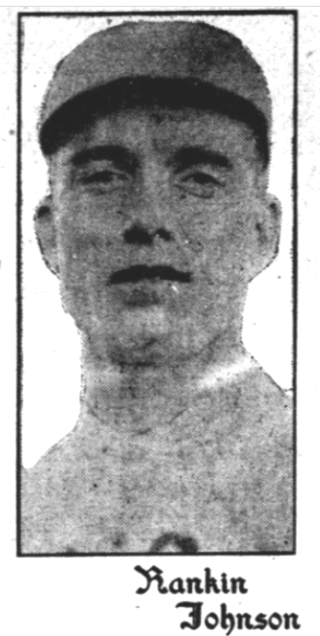
Adam Rankin "Tex" Johnson Sr. was a pitcher in Major League Baseball. His son, Rankin Johnson, Jr., was also a Major League pitcher. His grandfather was the Civil War military leader Stovepipe Johnson.

Henninger Field is a little-known, historic ballpark located in historic Chambersburg, Pennsylvania.
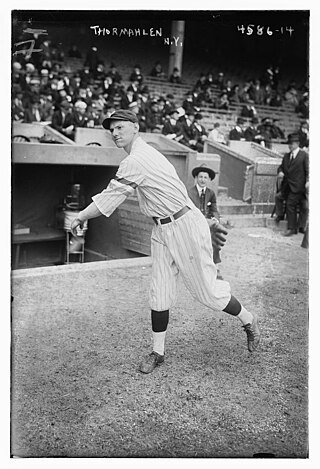
Herbert Ehler Thormahlen aka Lefty was a pitcher in Major League Baseball who played from 1917 through 1925 for the New York Yankees (1917–20), Boston Red Sox (1921) and Brooklyn Robins (1925). Listed at 6 ft 0 in (1.83 m), 180 lb., Thormahlen batted and threw left-handed. He was born in Jersey City, New Jersey.
Russell Collier "Rusty" Saunders, was an American Major League Baseball outfielder who played in 1927 with the Philadelphia Athletics. He was born and died in Trenton, New Jersey. He batted and threw right-handed. Saunders began his professional baseball career with the Chambersburg Maroons of the Blue Ridge League in 1927. He had a .983 fielding percentage playing in 95 games as part of the Chambersburg team that won the Blue Ridge Championship that year. After the Blue Ridge League season ended, Saunders was called up to the baseball major leagues. Saunders had a .133 batting average in five games, two hits in 15 at-bats, in his brief time in the majors. He continued to play minor league baseball through the 1931 season.

Kenneth Thomson "Mike" Knode was an American football and baseball player.
The Blue Ridge League was the name of two minor league baseball organizations that operated in the first half of the twentieth century in the United States.
Harry Lester Wilhelm was a pitcher in Major League Baseball for the 1899 Louisville Colonels. He attended Westminster College.
The Hagerstown Hubs were a Minor League Baseball team based in Hagerstown, Maryland, United States. The team played predominantly in the Blue Ridge League (1915–1930) and briefly in the Middle Atlantic League (1931). Their home games were in Willow Lane Park from 1915 to 1929 and Municipal Stadium during the 1930 and 1931 seasons.
Ivan Edward "Pete" Bigler was an American Major League Baseball player. Bigler appeared for the St. Louis Browns in one game on May 6, 1917 as a pinch runner. In the minor leagues he played outfield and third base. He attended Juniata College and Springfield College. He is a member of the Worcester Polytechnic Institute Athletic Hall of Fame.
Karl Dickey"Koley"Kolseth was a Major League Baseball first baseman who played for the Baltimore Terrapins of the Federal League in 1915.
The Parksley Spuds was a Class D minor league baseball team based in Parksley, Virginia, which had a population of just over 600 people at the 1920 United States Census. They played in the Eastern Shore League between 1922 and 1928, the entire run of the league's initial incarnation. The Spuds won multiple league pennants during that span. The league encountered financial difficulties during the 1928 season and the owners of the teams voted to disband the league.
The Martinsburg Blue Sox were an American minor league baseball team based in Martinsburg, West Virginia. They played in the Blue Ridge League between 1915 and 1929 and were an affiliate of the Philadelphia Athletics in 1929.
The Waynesboro Red Birds were a minor league baseball team based in Waynesboro, Pennsylvania. From 1920 to 1930, the Waynesboro Red Birds, "Cardinals" and "Villagers" teams played exclusively as members of the Class D level Blue Ridge League. The Waynesboro "Cardinals" and Red Birds were a minor league affiliate of the St. Louis Cardinals in 1925 and again from 1928 to 1930. Waynesville hosted home minor league games at E-B Park.
The Hagerstown Suns Minor League Baseball team was established in Hagerstown, Maryland, in 1981. The Suns remained in the Carolina League through 1988. In 1989, team ownership purchased the Williamsport Bills franchise of the Double-A Eastern League (EL) and relocated the team to Hagerstown. The Double-A Suns carried on the history of the Class A team that preceded it. After just four seasons, the Eastern League franchise left. The Myrtle Beach Hurricanes franchise of the Class A South Atlantic League (SAL) relocated to Hagerstown for the 1993 season where they became the Suns and continued the previous Suns teams' history.
The Cumberland Colts were a minor league baseball team based in Cumberland, Maryland between 1916 and 1932. The Cumberland Giants of the Pennsylvania-Ohio-Maryland League in 1906 and the 1907 Cumberland Rooters of the Western Pennsylvania League preceded the Colts. The Colts played as members of the 1916 Potomac League, the Blue Ridge League from 1917 to 1918 and Middle Atlantic League from 1925 to 1932. The Colts were a minor league affiliate of the New York Yankees in 1931 and 1932. With the Colts winning league championships in 1918, 1927 and 1931, Cumberland played home games at South End Park and then Community Park.
The Hanover Raiders were a minor league baseball team based in Hanover, Pennsylvania. Between 1915 and 1929, Hanover teams played exclusively as members of the Blue Ridge League from 1915 to 1917 and 1920 to 1929, winning the 1928 league championship. The 1915 Hanover Hornets preceded the Raiders, as Hanover played minor league home games at McAllister Field and then Young's Field
The Gettysburg Ponies were a minor league baseball team based in Gettysburg, Pennsylvania. From 1915 to 1917, Gettysburg teams played exclusively as members of the Class D level Blue Ridge League, beginning play in 1915 as the Gettysburg "Patriots." Gettysburg hosted minor league home games at Nixon Field




